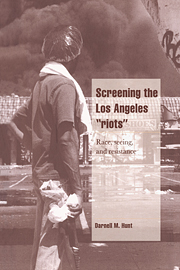Book contents
- Frontmatter
- Contents
- List of figures
- List of tables
- Preface
- 1 Introduction
- Part I Context and text
- 2 Media, race and resistance
- 3 Establishing a meaningful benchmark: the KTTV text and its assumptions
- Part II Audience
- Part III Analysis and Conclusions
- Postscript
- Appendix A Data and methods
- Appendix B Figures
- Appendix C KTTV Transcript
- Appendix D Questionnaires
- Appendix E Tables
- Notes
- References
- Index
3 - Establishing a meaningful benchmark: the KTTV text and its assumptions
Published online by Cambridge University Press: 23 January 2010
- Frontmatter
- Contents
- List of figures
- List of tables
- Preface
- 1 Introduction
- Part I Context and text
- 2 Media, race and resistance
- 3 Establishing a meaningful benchmark: the KTTV text and its assumptions
- Part II Audience
- Part III Analysis and Conclusions
- Postscript
- Appendix A Data and methods
- Appendix B Figures
- Appendix C KTTV Transcript
- Appendix D Questionnaires
- Appendix E Tables
- Notes
- References
- Index
Summary
The year 1963 was a landmark for television in the United States. In that year, the major television networks instituted their half-hour news programs, and a majority of people for the first time reported in a Roper poll that their chief source of news was television (Barnouw 1982). Ever since, television has reigned supreme as the people's source of news in the US. Indeed, informants for the present study are living testaments to this assertion: while about 43 percent reported never reading Los Angeles' major daily newspaper over the course of the events, only 3 percent of the sample reported not watching television news coverage of the events the first night (see table A.2, appendix A). This latter finding echoes viewership figures for the city as whole. Following initial reports of the verdicts, viewer levels were not much above normal across the stations in the city. But by primetime hours (i.e., by 8 pm), news of the police acquittals had spread throughout the city, as had reports of “violence,” “looting,” and other events of “protest.” By this time, 77 percent of the households in the city were tuned to local news coverage of the events (Los Angeles Times, May 1, 1992).
If, as I advocated in the previous chapter, we conceptualize the television experience as a continuous meaning-making process shaped by texts, viewers and their intertextual memories, then the present chapter focuses on the first of these factors. From what position or positions did the news media speak? What encoded meanings did study informants have to work with or struggle against as they made sense of the selected news text?
- Type
- Chapter
- Information
- Screening the Los Angeles 'Riots'Race, Seeing, and Resistance, pp. 35 - 50Publisher: Cambridge University PressPrint publication year: 1996



